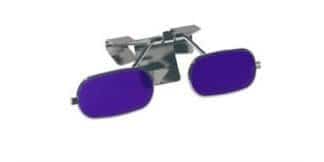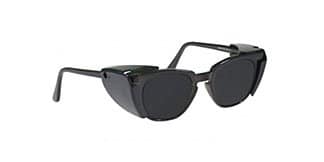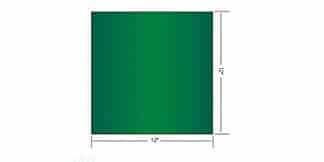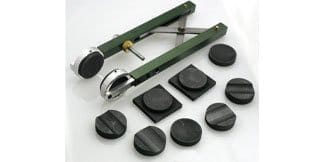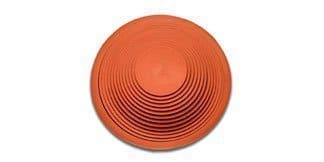The Regulations and Standards for Safety Glasses are different depending on what type of safety glasses you are looking for and for what job you are using them.
Safety glasses differ from standard eyewear as they are developed to provide significantly more protection to your eyes. For this reason, all safety glasses should carry the EN 166F Standard. EN 166F is the European certification for eye protection.
Its full name is EN 166 Personal Eye Protection European Standard and provides manufacturers with a minimum standard to adhere to for all personal protective equipment within Europe and thereby provide the customer with a guarantee that their PPE will provide adequate safety measures when used.
EN 166F is the main technical safety standard for all types of hazards when it comes to eye protection. This standard however, does not cover x-rays, lasers, nuclear radiation or infrared light.
If a pair of glasses is marked as EN 166 certified, it is deemed to protect you from hazards that may contribute to damage to your eyes. In order to meet this high certification level, the specific piece of eyewear must pass a series of tests which may include field of vision tests, stability to heat tests, resistance to UV light, optical transmission and diffusion tests, resistance to aging, resistance to corrosion, a wide range of robustness tests and resistance to ignition.
All glasses that are marked as EN 166 approved are extremely durable and this mark should provide you with peace of mind in knowing that your eyes are protected while you are at work or play.
Different Types of EN 166
The EN 166 standard is a broad category that covers several different types beneath it, all covering different elements of protection under its umbrella.
EN 166S: This is an enhanced robustness standard and is a specific standard for safety glasses. Both the lens and the frame of these glasses have been selected as being able to withstand a particular stress test.
The stress test includes a 22 mm steel ball being dropped from 1.3 metres onto the glasses. The ball weighs 43 grams and is dropped at a speed of 18 km per hour. Glasses in this category are deemed EN 166S if they do not shatter and remain in the frame itself, which also must remain intact. This test will ensure that your glasses withstand a huge amount of blunt force should the need occur.
EN 166F: This is the low energy impact standard, which will also provide you with protection against blunt force. In this test, a pair of glasses (both lens and frame) must remain intact when hit with a steel ball measuring 6mm, weighing 0.86g and is dropped onto the glasses at a speed of 162km per hour.
EN 166B: This is the European standard for safety goggles rather than safety glasses. Goggles provide wearers with additional durability and protection in harsh environments. The EN 166B standard is for medium energy impact tests. Any goggle that is classified as EN 166B has been tested to meet with the toughest standards.
If goggles withstand this test, it means that they have withstood a 6mm ball, weighing 86g being shot at a speed of 432 km per hour. This is significantly faster that the EN 166S and EN 166F tests above but is required to ensure that the goggles meet this pinnacle of safety standards.
There are a variety of other sub standards within the EN 166 certification. They all vary slightly to each other but exist to provide you with the comfort of knowing that your safety glasses can protect you when in the most challenging of conditions.
Regulations and Standards of Safety Glasses Markings of EN 166
You should also know how to look for these standards on any pair of safety glasses that you are considering purchasing.
You will need to check both the frames and the lens of the safety glasses in question.
Every pair of safety glasses will be stamped with a series of markings. There will be a manufacturers mark to let you know who produced the glasses but there should also be the stamp EN 166 and then a series of letters and numbers.
Each series of letters and numbers relates to a different categorisation. For example, if you see a ‘S’ on your safety glass frame then it means that this frame and lens have passed a series of robustness tests for general purposes. A ‘3’ corresponds to protection from chemical liquids.
The EN 166 standard exists to provide wearers with the confidence to know that the glasses you are using will protect you sufficiently in the environment for which you have chosen them.
Each lens created by a manufacturer will have engravings upon it to provide the necessary information as to what it is. These markings are limited so as not to restrict the field of vision.
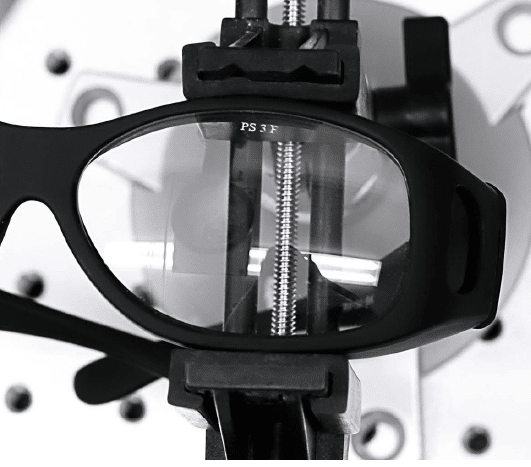
| Mark |
Lens Marking |
| 2C – 1.2 |
Protection level of the filter effect
(UV radiation, colour detection) |
| GA |
Identification mark of the manufacturer |
| 1 |
Optical Class |
| S or F |
Mechanical Strength |
| CE |
Conformity Mark |
Identification of Regulations and Standards of Safety Glasses on the glasses frame
The labelling of the glasses frame is clearly legible on the inside of the temple.
Frame temple markings
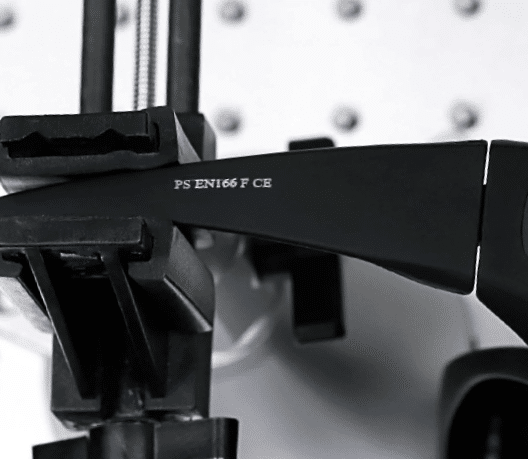
| Mark |
Lens Marking |
| GA |
Identification mark of the manufacturer |
| 166 |
Number of the standard EN DIN 166 |
| S or F |
Mechanical Strength |
| CE |
Conformity Mark |

